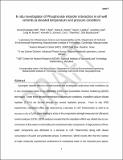| dc.contributor.author | Kupwade-Patil, Kunal | |
| dc.contributor.author | Boul, Peter J | |
| dc.contributor.author | Rasner, Diana K | |
| dc.contributor.author | Lapidus, Saul H | |
| dc.contributor.author | Leao, Juscelino B | |
| dc.contributor.author | Johnson, Kenneth D | |
| dc.contributor.author | Thaemlitz, Carl J | |
| dc.contributor.author | Büyüköztürk, Oral | |
| dc.date.accessioned | 2021-10-06T14:04:18Z | |
| dc.date.available | 2021-10-06T14:04:18Z | |
| dc.date.issued | 2020-08 | |
| dc.date.submitted | 2020-07 | |
| dc.identifier.issn | 1551-2916 | |
| dc.identifier.uri | https://hdl.handle.net/1721.1/132731 | |
| dc.description.abstract | The effect of a high-performance retarding additive in oil well cements was investigated under elevated temperature (165°C) and pressure (1000 psi) conditions via in situ synchrotron-based X-ray diffraction (XRD) and quasielastic neutron scattering (QENS) techniques. Under these temperature and pressure conditions, crystalline calcium silicate hydrates (C–S–H) are formed through the cement hydration process. From in situ XRD experiments, the retardation effect was observed by a change in the rate of the appearance of 11 Å tobermorites as well as a change in the rate of the α-C2SH generation and depletion. QENS analysis revealed that the retardation effect was related to the non-conversion of free water to chemical and constrained water components. A high presence of free water components was attributed to a decrease in 11 Å tobermorites along with slower consumption of the quartz and portlandite phases. Furthermore, QENS results infer that the water molecules experienced confinement in the restricted pore spaces. The retarder inhibited this initial water confinement by slowing the bulk diffusion of free water in the confined region. | en_US |
| dc.language.iso | en | |
| dc.publisher | Wiley | en_US |
| dc.relation.isversionof | http://dx.doi.org/10.1111/JACE.17373 | en_US |
| dc.rights | Creative Commons Attribution-Noncommercial-Share Alike | en_US |
| dc.rights.uri | http://creativecommons.org/licenses/by-nc-sa/4.0/ | en_US |
| dc.source | DOE repository | en_US |
| dc.title | In situ investigation of phosphonate retarder interaction in oil well cements at elevated temperature and pressure conditions | en_US |
| dc.type | Article | en_US |
| dc.identifier.citation | Kupwade-Patil, K, Boul, PJ, Rasner, DK, et al. In situ investigation of phosphonate retarder interaction in oil well cements at elevated temperature and pressure conditions. J Am Ceram Soc. 2020; 103: 6400– 6413 © 2020 American Ceramic Society (ACERS) | en_US |
| dc.contributor.department | Massachusetts Institute of Technology. Department of Civil and Environmental Engineering. Laboratory for Infrastructure Science and Sustainability | |
| dc.contributor.department | Massachusetts Institute of Technology. Department of Civil and Environmental Engineering | |
| dc.relation.journal | Journal of the American Ceramic Society | en_US |
| dc.eprint.version | Original manuscript | en_US |
| dc.type.uri | http://purl.org/eprint/type/JournalArticle | en_US |
| eprint.status | http://purl.org/eprint/status/NonPeerReviewed | en_US |
| dc.date.updated | 2021-10-05T17:25:41Z | |
| dspace.orderedauthors | Kupwade-Patil, K; Boul, PJ; Rasner, DK; Lapidus, SH; Leao, JB; Johnson, KD; Thaemlitz, CJ; Büyüköztürk, O | en_US |
| dspace.date.submission | 2021-10-05T17:25:42Z | |
| mit.journal.volume | 103 | en_US |
| mit.journal.issue | 11 | en_US |
| mit.license | OPEN_ACCESS_POLICY | |
| mit.metadata.status | Authority Work Needed | en_US |
